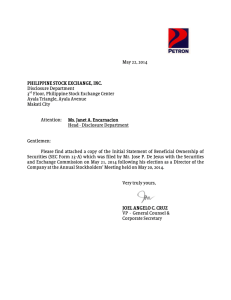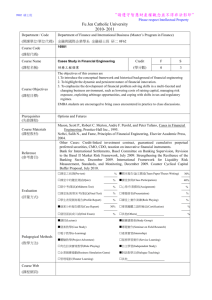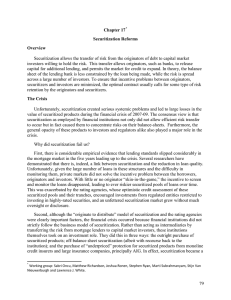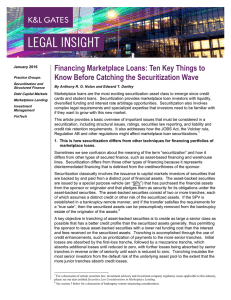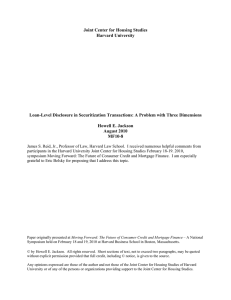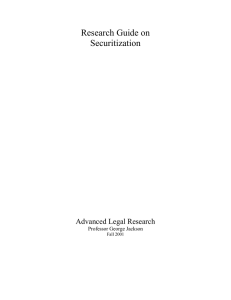On Financial Institutions
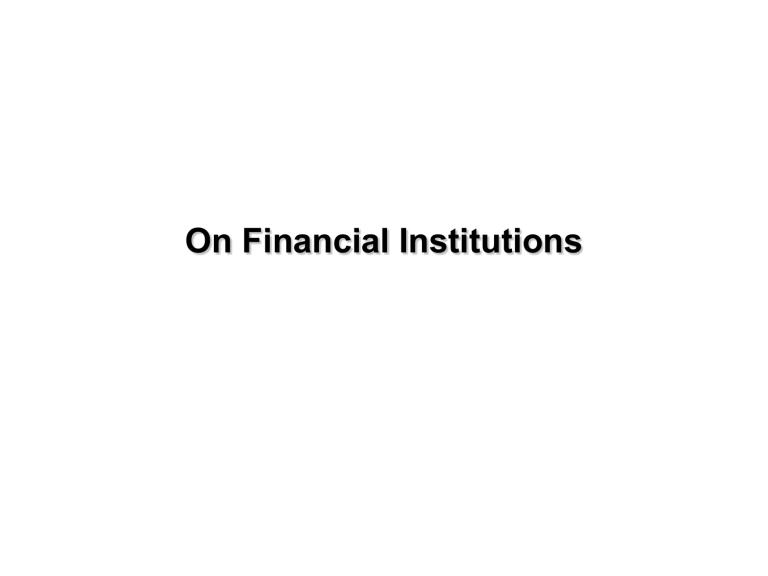
On Financial Institutions
Players in capital markets
• Governments: federal, provincial, state, municipal
• Nonfinancial Corporations
• Depository Institutions
• Insurance Companies
• Asset Management Firms
• Investment Banks
• Nonprofit Organizations
• Foreign Investors
A world without Financial Institutions
Financial claims would be contracted directly between fund providers and funds users.
Financial flows would be constricted due to:
• high search costs,
• high transaction costs
• high monitoring costs
• lack of liquidity
• risk
Financial Institutions: Why are they useful?
• Information and transaction economies of scale
• Liquidity services
• Payment services
• Risk services: transfer, diversification, and monitoring
• Transmission of monetary policy
• Intergenerational wealth transfers
Information and transaction economies of scale
A fund provider would incur high search costs trying to find on its own a fund user
A fund user would incur high search costs trying to find on its own a fund provider
FIs can dramatically reduce these costs
Newer technologies and the Internet, however, can also reduce these search and transaction costs.
Liquidity services
Definition of money
M1 : banknotes + coins + checking/current accounts
M2 : M1 + savings & term deposits + money-market funds
M3 : M2 + foreign currency holdings
All the secondary claims issued by FI to fund providers are far more liquid than the debt, equity, etc. held by FI
FI turn relatively illiquid assets into money or near-money
Payment services
Fi increase the efficiency and convenience of making payments:
-cheque clearing
-point-of-sale clearing
-ATM
-etc.
Risk services
Transfer of risk
• Contractual: Insurance
Diversification
• Pooling of assets: banks, mutual funds, etc.
Monitoring
• Ex: Covenants
Transmission of monetary policy
The Bank of Canada tries to control the money supply in order to achieve economic goals.
Levers: overnight rate and exchange rate
Any manipulation of outside money indirectly impacts inside money as well.
Outside money : notes, coins and central bank deposits
Inside money : the money supply produced by FI
Definition of money
M1 : banknotes + coins + checking/current accounts
M2 : M1 + savings & term deposits + money-market funds
M3 : M2 + foreign currency holdings
Inter-generations wealth transfer
From young to old
• Young people contribute to pension plans
From old to young
• Old people make their savings available for investment
Financial Institutions: How do they do it?
Brokerage
- conduit for disintermediated cash flows
Asset transformation and securitization
booking primary securities and issuing secondary securities
Financial Institutions vs. other corporations
Commercial firms
Use of funds : plant, machinery, patents, etc.
Source of funds : debt, equity
Financial intermediaries
Use of funds : debt, equity, and other securities
Source of funds : deposits, fund units, insurance policies, etc.
Financial Institutions: Why are they special?
Systemic risk : the failure of major FIs could trigger a domino effect throughout the economy.
Stringent regulation is required as a protection against negative externalities caused by systemic risk.
Financial Institutions: Regulation
Safety and soundness regulation
• Concentration limits for assets and investments
• Capital requirements to ensure solvency
• Guarantee funds CDIC, QDIC, CIPF
Investor protection regulation
• Protection against fraud and scams
• Disclosure
Entry and chartering regulation
• Influences the cost of entry and the profitability of FI
Justification of Regulation
The standard explanation for regulation is that the market, left to itself, cannot produce its goods and services in an efficient manner.
A market failure occurs when it cannot maintain all the requirements for a competitive situation. Most regulatory mechanisms resulted from the stock market crash of 1929 and the
Great Depression in the 1930s.
Forms of Federal Government Regulation of Financial
Markets
• Disclosure Regulation: The problem of “asymmetric information” between investors and managers requires regulation of disclosure. The “agent” manager invariably has better information than the investors. The U.S. has disclosure regulation in the form of the Securities Act of 1933 and the
Securities Exchange Act of 1934. These acts require certain disclosure by issuers, and the 1934 Act created the Securities and Exchange
Commission (SEC). The regulatory scheme is one of disclosure, and not one of evaluating investment opportunities.
• Financial Activity Regulation:R ules about traders of securities and trading on financial markets
• Regulation of Financial Institutions: Governmental monitoring of lending, borrowing, and funding.
• Regulation of Foreign Participants
Nature of Liabilities
• Type I Liabilities: Both the amount of the expected cash outflows and their timing are known (ex: GICs)
• Type II Liabilities: Cash outflows are known, but timing is not
(e.g., life insurance policies).
• Type III Liabilities: Cash outflows are unknown, but the timing of repayment is known (e.g., floating-rate certificates of deposit).
• Type IV Liabilities: Neither cash outflows nor their timing are known with certainty (e.g., most insurance products and pension obligations).
Financial Institutions: Trends
• Relative decline in bank deposits.
• Relative increase in pension and mutual funds.
• Banks, trust companies, insurance companies, and investment dealers are no longer The Four Pillars of the financial service industry.
• Cross-ownership and cross selling is on the rise.
• Concentration and consolidation of FI is on the rise.
• The advent of technology and of the internet allows for more disintermediation
Financial Innovation
The Economic Council of Canada has classified financial innovations into the three broad categories:
(1) market-broadening instruments,
(2) risk-management instruments, and
(3) arbitraging instruments and processes.
The following classification system is more specific and it was suggested by the Bank for International Settlements:
(1) price-risk transferring innovations,
(2) credit-risk transferring instruments, (3) liquidity-generating innovations,
(4) credit-generating instruments, and
(5) equity-generating instruments.
•Motivation for Financial Innovation
•There are two extreme views of financial innovation: (1) innovation represents efforts to circumvent (or “arbitrage”) regulation and find loopholes to tax rules; or (2), innovation provides more efficient vehicles or processes for redistributing risks among market participants. Many innovations ultimately result in greater efficiencies.
More...
J oseph Schumpter:
(1) process innovation is one in which an existing product can be produced or service provided more efficiently than that of a current existing product or service.
(2) product innovation means the introduction of a new product or service that does not currently exist in the market.
Stephen Ross suggests the following two classes of financial innovation:
(1) new financial products, (financial assets and derivative instruments) better suited to the circumstances of the time (e.g. to inflation) and the markets in which they trade; and
(2) dynamic trading strategies that primarily use these financial products.
Motivation for Financial Innovation
There are two extreme views of financial innovation:
(1) innovation represents efforts to circumvent (or “arbitrage”) regulation and find loopholes to tax rules; or
(2) innovation provides more efficient vehicles or processes for redistributing risks among market participants.
The fundamental causes of financial innovation are:
(1) increased volatility of interest rates, inflation, exchange rates, and/or equity prices,
(2) advances in computer and telecommunications technologies,
(3) greater sophistication and educational training of professional market participants,
(4) financial intermediary competition,
(5) incentives to get around regulations and/or tax laws,
(6) changing global patterns of financial wealth.
Securitization
Securitization is a process by which a financial relationship is converted into a financial transaction.
Corporate bonds is an example of the result of a securitization, i.e., the process of borrowing moving from banks (financial relationship) to the issuance of bond (financial transaction). Securitization represents the evolution of financial markets beyond the role of the traditional banking firm.
SECURITIZATION UNDERSCORES THE INTERPLAY BETWEEN ARM'S
LENGHT CONTRACTING AND TRUST IN THE FUNCTIONING OF
FINANCIAL MARKETS AND INSTITUTIONS
There is a general movement in the financial markets is in the direction of using the public market rather than relying on financial intermediaries to take on risks, including insurance risks.


